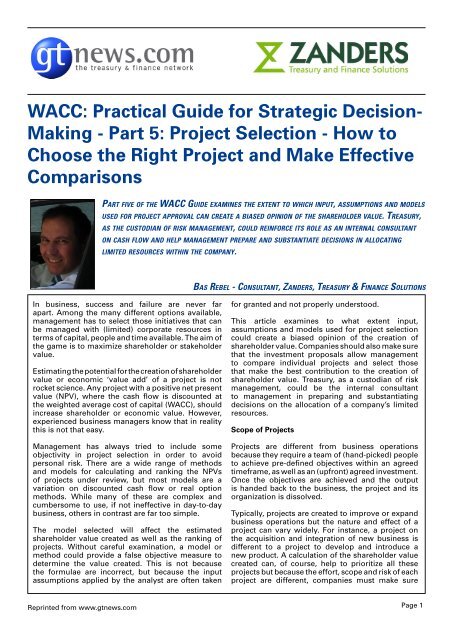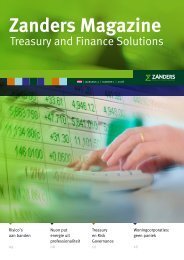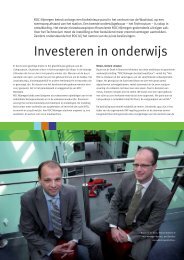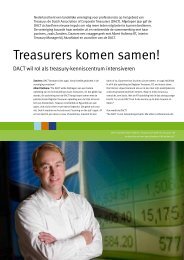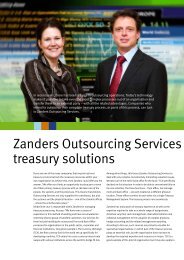WACC: Practical Guide for Strategic Decision- Making - Part 5 ...
WACC: Practical Guide for Strategic Decision- Making - Part 5 ...
WACC: Practical Guide for Strategic Decision- Making - Part 5 ...
Create successful ePaper yourself
Turn your PDF publications into a flip-book with our unique Google optimized e-Paper software.
<strong>WACC</strong>: <strong>Practical</strong> <strong>Guide</strong> <strong>for</strong> <strong>Strategic</strong> <strong>Decision</strong>-<br />
<strong>Making</strong> - <strong>Part</strong> 5: Project Selection - How to<br />
Choose the Right Project and Make Effective<br />
Comparisons<br />
In business, success and failure are never far<br />
apart. Among the many different options available,<br />
management has to select those initiatives that can<br />
be managed with (limited) corporate resources in<br />
terms of capital, people and time available. The aim of<br />
the game is to maximize shareholder or stakeholder<br />
value.<br />
Estimating the potential <strong>for</strong> the creation of shareholder<br />
value or economic ‘value add’ of a project is not<br />
rocket science. Any project with a positive net present<br />
value (NPV), where the cash flow is discounted at<br />
the weighted average cost of capital (<strong>WACC</strong>), should<br />
increase shareholder or economic value. However,<br />
experienced business managers know that in reality<br />
this is not that easy.<br />
Management has always tried to include some<br />
objectivity in project selection in order to avoid<br />
personal risk. There are a wide range of methods<br />
and models <strong>for</strong> calculating and ranking the NPVs<br />
of projects under review, but most models are a<br />
variation on discounted cash flow or real option<br />
methods. While many of these are complex and<br />
cumbersome to use, if not ineffective in day-to-day<br />
business, others in contrast are far too simple.<br />
The model selected will affect the estimated<br />
shareholder value created as well as the ranking of<br />
projects. Without careful examination, a model or<br />
method could provide a false objective measure to<br />
determine the value created. This is not because<br />
the <strong>for</strong>mulae are incorrect, but because the input<br />
assumptions applied by the analyst are often taken<br />
Reprinted from www.gtnews.com<br />
<strong>Part</strong> five of the WaCC <strong>Guide</strong> examines the extent to WhiCh inPut, assumPtions and models<br />
used <strong>for</strong> ProjeCt aPProval Can Create a biased oPinion of the shareholder value. treasury,<br />
as the Custodian of risk manaGement, Could rein<strong>for</strong>Ce its role as an internal Consultant<br />
on Cash floW and helP manaGement PrePare and substantiate deCisions in alloCatinG<br />
limited resourCes Within the ComPany.<br />
bas rebel - Consultant, Zanders, treasury & finanCe solutions<br />
<strong>for</strong> granted and not properly understood.<br />
This article examines to what extent input,<br />
assumptions and models used <strong>for</strong> project selection<br />
could create a biased opinion of the creation of<br />
shareholder value. Companies should also make sure<br />
that the investment proposals allow management<br />
to compare individual projects and select those<br />
that make the best contribution to the creation of<br />
shareholder value. Treasury, as a custodian of risk<br />
management, could be the internal consultant<br />
to management in preparing and substantiating<br />
decisions on the allocation of a company’s limited<br />
resources.<br />
Scope of Projects<br />
Projects are different from business operations<br />
because they require a team of (hand-picked) people<br />
to achieve pre-defined objectives within an agreed<br />
timeframe, as well as an (upfront) agreed investment.<br />
Once the objectives are achieved and the output<br />
is handed back to the business, the project and its<br />
organization is dissolved.<br />
Typically, projects are created to improve or expand<br />
business operations but the nature and effect of a<br />
project can vary widely. For instance, a project on<br />
the acquisition and integration of new business is<br />
different to a project to develop and introduce a<br />
new product. A calculation of the shareholder value<br />
created can, of course, help to prioritize all these<br />
projects but because the ef<strong>for</strong>t, scope and risk of each<br />
project are different, companies must make sure<br />
Page 1
they make accurate and meaningful comparisons<br />
between projects.<br />
1. Cash flow projections<br />
Each model starts with a <strong>for</strong>ecast of project cash<br />
inflow and outflow. By its very nature, the validity<br />
of a <strong>for</strong>ecast is highly dependent on the underlying<br />
assumptions, and most models recognize that<br />
cash flow projections cannot be 100% accurate.<br />
More complex models include a sensitivity testing<br />
function but this takes considerable ef<strong>for</strong>t to build.<br />
Many companies take shortcuts by varying the<br />
net or gross cash flows as calculated <strong>for</strong> the base<br />
case. These shortcuts might give an inaccurate view<br />
because varying the value of (net) cash flow does not<br />
recognize the fact that delayed projects could incur<br />
not only higher cost but also costs over a prolonged<br />
period. As a result, revenues could be lower than<br />
anticipated or the expected cash inflows from that<br />
project may be delayed. In fact, any delay to the<br />
anticipated cash inflow can have a disproportionate<br />
effect on the NPV of the project.<br />
A second issue related to cash flow projection is<br />
what elements should be included. Some companies<br />
include only ‘hard dollar savings’, ignoring ‘soft<br />
dollar savings’, such as unlocking partial full-time<br />
equivalents (FTEs) allowing staff to focus on (other)<br />
value adding activity, or existing cash flow that<br />
might be jeopardized if the project is not accepted.<br />
Other benefits, such as security, market perception<br />
or quality of data, are even more difficult - if not<br />
impossible - to quantify. And, even if they were, it<br />
would still be difficult to quantify their contribution<br />
to individual projects.<br />
The more companies focus on ‘hard dollar savings’,<br />
the more projects will need to focus on core<br />
business operations. As a result, projects that would<br />
significantly improve the quality of management<br />
in<strong>for</strong>mation systems without reducing headcount<br />
might be overlooked. Short and low risk projects<br />
with a small upfront investment will be considered<br />
a higher priority than larger, more risky projects. For<br />
instance, projects building on existing infrastructure<br />
to create incremental benefits will typically be<br />
favoured above projects that result in a paradigm<br />
shift within the organisation.<br />
A third issue is the horizon of the cash flow projection.<br />
For comparison purposes, companies often have<br />
standard projection horizons of three or five years.<br />
However, the longer the project implementation takes,<br />
the longer it will take <strong>for</strong> the benefit to materialize.<br />
Prefixed horizons favour projects with ‘quick wins’,<br />
low investments and short implementation. Important<br />
infrastructure projects might not return a significant<br />
positive NPV over a three-year period. On the other<br />
hand, projects with lasting ‘quick wins’ contribute a<br />
benefit after three, four or even 10 years - long after<br />
anybody would even remember the objectives!<br />
If one sets the horizon of projections in a different<br />
way <strong>for</strong> each project, comparing the projects will not<br />
be straight<strong>for</strong>ward. If one assumes that projects<br />
are considered only to the extent that they enhance<br />
shareholder or stakeholder value, the relevant horizon<br />
should be adjusted to the profile of stakeholders.<br />
2. Discount factor<br />
After the projections have been validated, the next<br />
step is to discount cash flows in order to make the<br />
NPV comparable. In theory, the <strong>WACC</strong> represents<br />
the rate at which projects will start generating<br />
shareholder value. The <strong>WACC</strong> is the weighted<br />
average cost of capital though and if a company<br />
is treated as a portfolio of projects, the <strong>WACC</strong> is a<br />
reflection of all activities and risks inherent in the<br />
company’s businesses. Furthermore, the <strong>WACC</strong> is<br />
not constant over time. Among other factors, the<br />
<strong>WACC</strong> depends on the risk free rate, the company’s<br />
funding strategy (leverage) and risk profile. Each<br />
of these factors will change over time and can be<br />
different <strong>for</strong> each business line or project. The cost<br />
of capital should there<strong>for</strong>e be agreed individually <strong>for</strong><br />
each project, and there are a number of issues that<br />
need attention.<br />
Allocation of equity and debt<br />
The allocation of equity and additional funding to<br />
projects is an important factor <strong>for</strong> the calculated NPV.<br />
Using the current <strong>WACC</strong> <strong>for</strong> the calculation disregards<br />
the effect a project might have on company leverage<br />
when approved. Using the current <strong>WACC</strong> will also<br />
underestimate the shareholder value created by the<br />
project if additional (senior) funding is put in place.<br />
However, in a similar case, the marginal approach<br />
to the project cost of capital would allocate all new<br />
(senior) funding disproportionately to the new<br />
project and thus overestimate the shareholder value<br />
to be created.<br />
Another approach to this issue is to estimate the<br />
risk profile of an individual project and allocate<br />
equity accordingly. Depending on the magnitude<br />
and profile of projects in the portfolio, this might<br />
imply that a company could have a temporary or<br />
permanent equity surplus (or shortage). All projects<br />
should then compensate <strong>for</strong> this difference in order<br />
to satisfy stakeholders’ requirements.<br />
A project cost of capital curve<br />
The <strong>WACC</strong> will change over time as a result of market<br />
fluctuations and funding strategies. It is there<strong>for</strong>e not<br />
unreasonable to discount the first year cash flow at a<br />
different rate than that of the fourth or fifth year. The<br />
curve <strong>for</strong> the cost of capital <strong>for</strong> an individual project<br />
does not have to correlate to a risk-free yield curve.<br />
The leverage strategy and change in the company’s<br />
risk profile will also affect this curve.<br />
3. Identifying project risk<br />
Each project will have a specific risk profile. The real<br />
option method tries to treat each risk component as<br />
a decision ‘option’ and estimates the value of each<br />
one using standard option calculation methods. The<br />
result of this approach to project risk is dependent on<br />
Reprinted from www.gtnews.com Page 2
the predicted accuracy of the decisions, likelihood of<br />
each option available and timing of such occasions.<br />
The more options involved in each decision, the<br />
more difficult it will be to verify the assumptions and<br />
thus validate the outcome.<br />
Other simpler and widely used models will increase<br />
the discount factor with a risk premium. This<br />
approach will not favour projects with a high upfront<br />
investment and long impact horizon. Outsourcing<br />
projects that convert fixed investments into variable<br />
cost might also benefit disproportionately from this<br />
approach to project selection.<br />
Risk is project specific and sometimes even option<br />
specific, i.e. two alternative approaches to the same<br />
project might have different risk profiles. The case<br />
<strong>for</strong> outsourcing a project to two different countries<br />
might have an identical cash flow; however, the<br />
market might see one as a higher risk than the other<br />
(e.g. as a result of additional country risk). Allocating<br />
additional equity to one project or adjusting the<br />
company <strong>WACC</strong> with a country specific outlook are<br />
alternative approaches <strong>for</strong> incorporation of such risk<br />
elements.<br />
Individual projects can potentially affect the<br />
overall company risk profile. Acquisitions or major<br />
investments could affect the company beta and<br />
change the overall cost of capital. If these changes are<br />
not incorporated in the project NPV, the contribution<br />
to shareholder value can easily be misjudged. A<br />
marginal approach to allocating the cost (or benefit)<br />
of changing the company risk profile is tempting,<br />
especially when companies execute a diversification<br />
strategy. However, quite a few companies do feel<br />
the pressure of trying to capitalize on a break-up<br />
premium.<br />
To address the element of risk, some methods will use<br />
a less complex approach by increasing the standard<br />
project discount factor. This risk factor might vary<br />
from project to project and this approach to risk<br />
favours projects with ‘quick wins’ early on in the<br />
Reprinted from www.gtnews.com<br />
project. This can be at the expense of projects with<br />
long-term structural impact because of the reduced<br />
NPV of cash flows over a long period of time. For the<br />
same reason, the method also favours projects with<br />
small upfront investments.<br />
A Role <strong>for</strong> Treasury<br />
In order to substantiate and motivate the value created<br />
by projects, companies need to ensure that cash flow<br />
projections and project risk are modelled in such a<br />
way that the outcome is comparable. Project support<br />
offices (if available) are hardly ever equipped <strong>for</strong> this<br />
task. Treasury as the custodian of cash <strong>for</strong>ecasting,<br />
risk management and fair value calculation, is ideal<br />
<strong>for</strong> this job. It would make perfect sense <strong>for</strong> treasury<br />
to develop useful models <strong>for</strong> project managers and<br />
evaluate the business case documents <strong>for</strong> executive<br />
management. In this way, treasury would be able to<br />
rein<strong>for</strong>ce its role as an internal consultant on cash<br />
flow and risk management.<br />
Conclusion<br />
Many companies put a lot of ef<strong>for</strong>t into modelling<br />
the benefits of projects prior to approval. Allocating<br />
scarce resources in order to ensure a successful<br />
project is an important responsibility of management<br />
and they should understand how an adopted model<br />
is applied within a project. Validating the motivation<br />
behind input and stress testing of cash flow<br />
projections is probably more important than the<br />
fact that, on paper, projects will return the value that<br />
makes them eligible <strong>for</strong> approval. Treasury can use<br />
its expertise to assist management and make sure<br />
the company chooses the best projects.<br />
It is important to look beyond mere numbers and<br />
not focus on the difference of 1% or 2% in the NPV;<br />
remember there is always an element of art and ‘gut<br />
instinct’ in project selection. Management should<br />
there<strong>for</strong>e treat project analysis as a tool to support<br />
their strategic decision-making within the company.<br />
Page 3
Bas Rebel is a consultant with Zanders, Treasury & Finance Solutions. He has over 14 years of experience<br />
in consulting, corporate treasury management, product management and banking. He has a broad<br />
understanding of treasury issues, especially related to transaction processing and in<strong>for</strong>mation management<br />
within complex organizations. At Zanders he is responsible <strong>for</strong> the cash qflow management addressing issues<br />
related to working capital management, payment strategies, banking structures and treasury automation.<br />
Zanders, Treasury & Finance Solutions is a specialist in treasury management, treasury IT, corporate finance,<br />
risk management and asset & liability management. Our field includes all activities aimed at the financing<br />
and financial risks of a company and any future changes therein. Zanders was incorporated in 1994 and<br />
employs approximately 50 specialised consultants to provide advice to a diverse range of companies and<br />
government bodies, including banks, pension funds, multinational enterprises, municipalities, hospitals,<br />
housing corporations.<br />
www.gtnews.com is the number one global in<strong>for</strong>mation resource <strong>for</strong> senior finance and treasury professionals. Updated<br />
weekly, gtnews provides in<strong>for</strong>med commentry, news and analysis from hundreds of key players throughout the<br />
sector. Topics covered include banking, risk, payments, technology, cash management, working capital, outsourcing,<br />
capital markets, online trading, careers and systems. gtnews also features news, surveys, job listings, directories,<br />
guides, ratings, Q&A <strong>for</strong>ums & events diaries. gtnews is free to read so register today at www.gtnews.com<br />
Reprinted from www.gtnews.com<br />
Page 6


